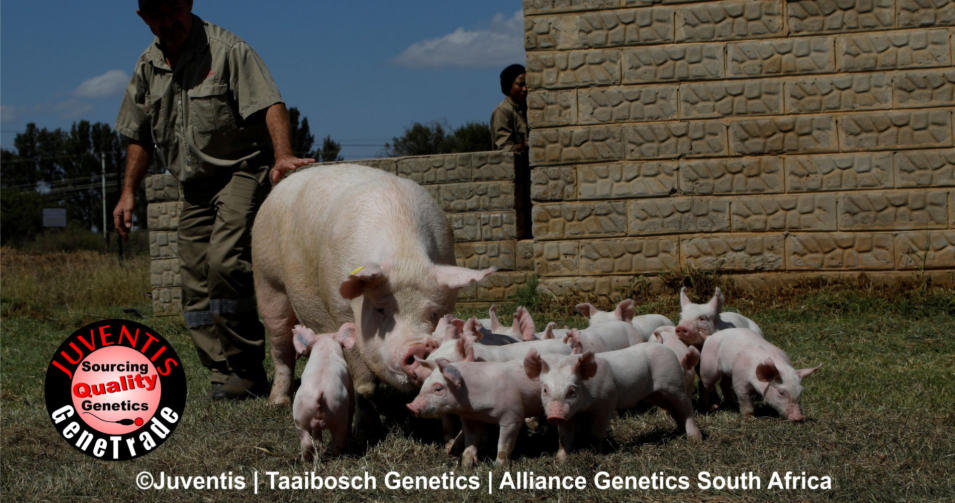Factors that will determine the success of practical pig breeding / pig farming
•
“Well-planned
breeding
objectives:
The
ultimate
objective
is
to
improve
profitability,
where:
Profit
(P)
=
Returns(R)
-
Cost(C)
or
P
=
R
-
C.
Hence,
only
traits
that
have
a
significant
economic
value
(and
which
will
improve
profitability)
should
therefore
be
included
in
the
breeding objective.
•
Once
the
breeding
objective
has
been
finalized
and
the
most
important
economic
traits
identified,
economic
weights
must
be
allocated
to
the
overall
objective.
Re-evaluation
of
the
economic
weights
must
be
done
on
a
regular
basis
(every
two
to
three
years).
The
estimation
of
genetic
parameters
should
be
conducted
every
four
to
five
years
in
order
to
keep
the
breeding
objectives
relative
and
related
to
market
(user & consumer) demands.
•
The
choice
of
the
most
effective
pig
breeding
programme.
This
will
largely
be
determined
by
the
traits
and
their
genetic
relationships
(the
production system will also influence traits to be included in a breeding objective).
•
The
purchase
of
genetically
superior
animals
from
reputable
breeding
companies,
stud
breeders
or
multiplier
herds.
This
aspect
is
particularly important when establishing a breeding herd - right from the beginning.
•
Knowledge of the size of the various breeds that are available, as continued genetic improvement is influenced by the following:
o
Increased selection pressure as a result of increased numbers that are performance tested (while the opposite is also true).
o
Availability of sufficient variation (the raw material of genetic improvement) which will slow down attaining the selection limit.
•
The availability of unique genes, which could comply with changing market requirements in future.
•
Careful
record-keeping,
easy
identification
of
all
breeding
animals
and
their
progeny
(24
x
7
x
365)
and
prudent
use
of
BLUP
(along
with
high accuracy of breeding values) and genomics in future.
•
Breeding animals must be compared in the right contemporary groups.
•
The application of AI within a herd should be > 90%.
•
Identify
and
evaluate
the
genetic
supplier
carefully,
ascertain
the
availability
of
the
pig
breed
on
a
national
and
international
basis
(size
of
gene pool) and pay realistic and affordable prices for breeding animals.
•
Bio-security
and
high
health
have
become
synonymous
with
modern
pig
production.
Differentiation
of
sire
and
dam
lines
and
traits
to
select
for in each line are summarized”
Excerpt:
Modern Pig Production
A study by Kruger (2015) where the genetic analysis of the performance of 87 121 progeny that were born and performance tested from 3 152
AI boars from local and imported sires were compared over a period of 14 years (2000 - 2014), have indicated limited superiority of the
imported semen. Hence, it is very important to use the right methods to identify those very top performing AI boars



The F1-crossbred pig in South Africa
•
The classical F1 crossbred sow, is the result of crossing the Large White pig breed and the Landrace pig breed as well as their
resipirocal cross. These animals form the basis of numerous commercial production units locally and abroad.
•
The resultant hybrid vigour is achieved in all the reproductive traits and to a lesser extent in the production and carcass traits.
•
The progeny of crossbred sows are known to grow better pre-weaning whereas the F1 sow produce more milk (a higher litter
weaning weight), as well as more piglets per litter that are robust and that generally survive better.


Please see the Juventis: Pig Breeds page for more information on the Duroc, Landrace and Large White pig breeds in South Africa

Copyright © Juventis | Website Design by Juventis Studio

Worldwide pig breeding had been commercialized, with less breeding companies and less private breeders, each securing a bigger pro rata market
share respectively. By introducing new genotypes in new environments, cognisance must be taken of genotype x environmental interactions -
especially during the initial post introduction years. This phenomenon has a biological, adaptive and genetic connectivity basis.
The crossing of different purebred pig breeds or the crossing of different genotypes will still be the future of nucleus and commercial pig
production. Today more advanced tegnology and biotechnology as well as internationally connected databases and genomic information are being
used in international pig breeding programs. It stands to reason that positive heterosis can only be generated from purebreds or genotypes that
show a continious and upward spiral of genetic progress.
Juventis GeneTrade
Juventis GeneTrade: Sourcing, visual appraisal and selection of customer spesific quality pig genetics and pig
products for pig breeding South Africa and abroad (AGSA).
Focussing on specific mandate driven requests.













